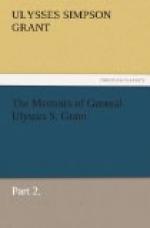Up to this time my regiment had not been carried in the school of the soldier beyond the company drill, except that it had received some training on the march from Springfield to the Illinois River. There was now a good opportunity of exercising it in the battalion drill. While I was at West Point the tactics used in the army had been Scott’s and the musket the flint lock. I had never looked at a copy of tactics from the time of my graduation. My standing in that branch of studies had been near the foot of the class. In the Mexican war in the summer of 1846, I had been appointed regimental quartermaster and commissary and had not been at a battalion drill since. The arms had been changed since then and Hardee’s tactics had been adopted. I got a copy of tactics and studied one lesson, intending to confine the exercise of the first day to the commands I had thus learned. By pursuing this course from day to day I thought I would soon get through the volume.
We were encamped just outside of town on the common, among scattering suburban houses with enclosed gardens, and when I got my regiment in line and rode to the front I soon saw that if I attempted to follow the lesson I had studied I would have to clear away some of the houses and garden fences to make room. I perceived at once, however, that Hardee’s tactics—a mere translation from the French with Hardee’s name attached —was nothing more than common sense and the progress of the age applied to Scott’s system. The commands were abbreviated and the movement expedited. Under the old tactics almost every change in the order of march was preceded by a “halt,” then came the change, and then the “forward march.” With the new tactics all these changes could be made while in motion. I found no trouble in giving commands that would take my regiment where I wanted it to go and carry it around all obstacles. I do not believe that the officers of the regiment ever discovered that I had never studied the tactics that I used.
CHAPTER XIX.
Commissioned brigadier-general—command at Ironton, Mo.—Jefferson city —Cape Girardeau—general Prentiss—seizure of Paducah—headquarters at Cairo.
I had not been in Mexico many weeks when, reading a St. Louis paper, I found the President had asked the Illinois delegation in Congress to recommend some citizens of the State for the position of brigadier-general, and that they had unanimously recommended me as first on a list of seven. I was very much surprised because, as I have said, my acquaintance with the Congressmen was very limited and I did not know of anything I had done to inspire such confidence. The papers of the next day announced that my name, with three others, had been sent to the Senate, and a few days after our confirmation was announced.




